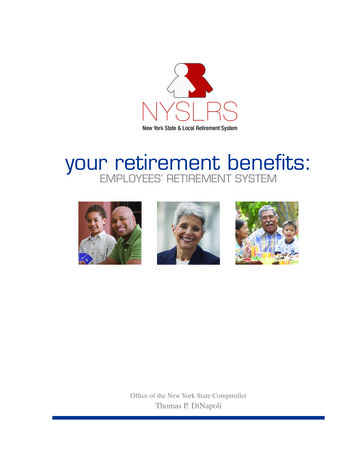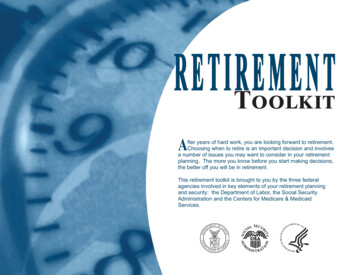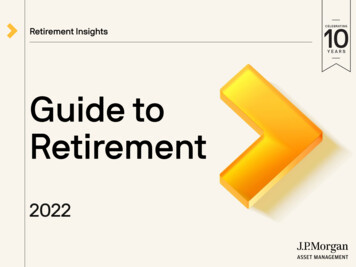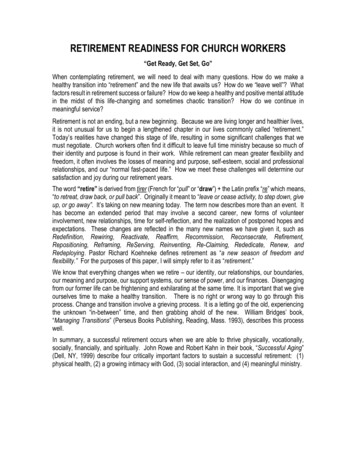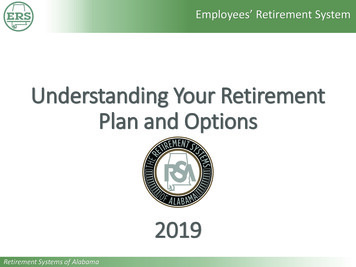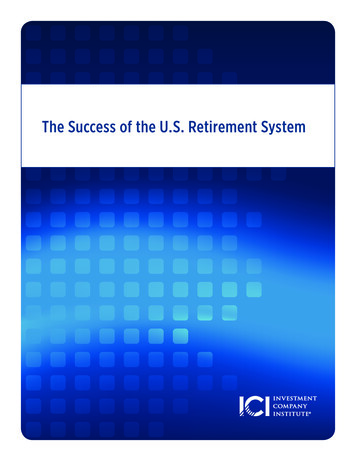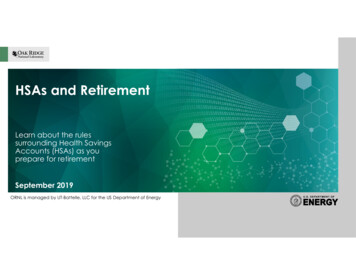
Transcription
HSAs and RetirementLearn about the rulessurrounding Health SavingsAccounts (HSAs) as youprepare for retirementSeptember 2019ORNL is managed by UT-Battelle, LLC for the US Department of Energy
Health Savings Accounts (HSAs) offer many advantages whenpreparing for health care expenses in retirement. HSAs offer triple tax savings. The money you contribute is taxdeductible, your savings grow tax free, and money used forqualified medical expenses is tax free. Money is always yours. There is no “use it or lose it” rule, and moneyis portable if you change jobs, medical plans, or retire. You are in control of the funds. You decide how much to contribute,when to use the funds, and whether or not to invest the funds forpotential long-term growth.2
A few general rules about opening and/or contributingto an HSA: Employee cannot be covered by a non-qualified health plan, or by a spouse’sHealth Care Flexible Spending Account. Employee cannot be claimed as adependent on another individual's taxreturn. Employee cannot be enrolled in MedicarePart A or TRICARE. However, an employeecan contribute to an HSA if their spouse isenrolled in Medicare.3
Approaching retirement – under age 65Employees can elect Consumer Choice and open and/or contributeto an HSA as a way to build savings for retirement.Eligible employees will receive any employer HSA contributionsthat apply.Employees age 55 and older can contribute the annual HSAmaximum, plus an additional 1,000 catch-up contribution.4
Approaching retirement – age 65 and olderMedicareeligibilityAt age 65, you become eligible for Medicare benefits whether youremain an active employee or retire.MedicareEmployees enrolled in Medicare are no longer eligible to makecontributions to an HSA. However, a spouse’s Medicare enrollmentdoesn’t affect the employee’s eligibility to contribute.and HSAsMedicareenrollmentCatch-upcontribution5Note: Receiving Social Security retirement benefits automatically enrolls you inMedicare Part A. This includes you drawing a spousal income benefit.Active employees have the option to delay Medicare enrollment orwithdraw from Medicare Part A in order to open and/or contribute toan HSA and receive ORNL contributions to an HSA. The choicedepends on your personal situation.Employees age 55 and older can contribute the annual HSA maximum,plus an additional 1,000 catch up contribution.
Enrolling in Medicare when you retireIf you delayed Medicare enrollment as an active employee: ORNL Benefits will give you a special enrollment form whencompleting retirement paperwork to enroll in Medicare withoutincurring a late enrollment penalty. Plan accordingly. You must stop all HSA contributions 6 months priorto enrolling in Medicare and/or collecting Social Security. This isbecause Medicare Part A will be retroactive up to 6 months (but notprior to Medicare eligibility), and any HSA contributions made duringthose months are subject to a tax penalty.Once enrolled in Medicare, you can use your HSA funds tax free forqualified medical expenses. For a list of qualified medical expenses, see IRS Publication 502:https://www.irs.gov/pub/irs-pdf/p502.pdf Please note that Medicare supplement (Medigap) premiums arenot considered a qualified medical expense.6
HSAs in retirementIn retirement, you can: Use your HSA funds for qualified medical expenses.See IRS Publication 502: https://www.irs.gov/pub/irs-pdf/p502.pdfNote: You cannot use an HSA to pay your Medicare supplement premium. Use your HSA funds for non-qualified medical expenses starting atage 65 and only pay federal income tax.However, please know you: No longer receive the employer contribution from ORNL. Cannot contribute to your HSA through payroll deduction. Can contribute directly to your HSA and deduct contributions fromincome on Form 8889. You won’t pay federal income tax, but youwill pay Social Security and Medicare tax (7.65%).7
Retiring before December 1 in a given year?HSA contributions for employees who retire before December 1 in a givenyear may be subject to a prorated calculation of the HSA contribution limit.This would only apply if you lose eligibility to contribute to an HSA during theyear due to: Under Age 65 – Being enrolled in a high-deductible health plan for only aportion of a year Age 65 or older – Being enrolled in Medicare Part AIf applicable, the HSA contribution limit in a given year is prorated todetermine the total amount allowed to be contributed to your HSA in thatyear. Anything contributed over this amount is subject to a 6% excise tax.8
Example of proration of HSA contribution limitScenarioHSA annual contribution limit 12 months-Employee is age 67* 8,100 includes 1,000 catch-up contribution-Retiring on 9/1/2020* 8,100 12 675-Has family coverageNumber of months eligible to contribute (Jan and Feb)x2-Medicare Part A iseffective 3/1/2020Total amount allowed to contribute to HSA in 2020 1,350(6-month retroactive rule)CalculatingexcesscontributionamountORNL contribution deposited in early JanuaryEmployee’s total contributions for January – AugustTotal amount contributed to HSA at retirementTotal amount allowed to contribute to HSA in 2020Amount that’s exceeded the allowable contribution 1,500 4,400 5,900- 1,350 4,550In this example, the employee must contact Optum Bank before 4/15/2021 totake a distribution of the excess amount in order to avoid paying a 6% excise tax.9
Worksheet to determine your 2020 HSA contribution limit partial year eligibilityThis worksheet is to assist employees in determining how much they can contribute to an HSA if they won’t be eligibleto contribute the entire year due to enrollment in Medicare, TRICARE, or non high-deductible health plan (HDHP).Individual Dual/Familycoveragecoverage#1.Federal HSA contribution limit for 2020#2.Add 1,000 if you’re age 55 or older in 2020 for the catch-up contribution#3.Add #1 #2 total HSA contribution limit for 2020#4.Divide limit in #3 by 12#5. 3,550 7,100 750 1,500Number of months you are not enrolled in Medicare, TRICARE, or non HDHP(Note that if you’re over age 65 when you retire, the effective date of MedicarePart A will be 6 months before your retirement date, e.g. retire 9/1, Part A effective 3/1)#6.Multiply #4 x #5 maximum amount that can be deposited into your HSA(employer employee)#7.HSA employer contribution from ORNL#8.Subtract #6 - #7 maximum amount you can contribute to your HSA in 2020If total contributions in 2020 exceed the allowable amount on #6, you will need to contact Optum Bank to take adistribution of the excess amount before April 15, 2021 in order to avoid a 6% excise tax.10
ResourcesSocial Security Administration: 1-800-772-1213Social Security – Getting Benefits While rking.htmlHSAs and Other Tax-Favored Health Plans (IRS Publication ng for Retirement with an HSAhttps://benefits.ornl.gov/2019/pdf/OptumUHC HSA Planning for Retirement.pdfHSAs and Mid-Year sumeractivation/unknown/HSA Mid Year Changes.pdf11
ContactsORNL BenefitsP.O. Box 2008Bldg. 4007, MS 6465Oak Ridge, TN 37831ornlbenefits@ornl.gov1-865-576-7766 (local)1-866-576-7766 (toll-free)12
Approaching retirement – under age 65 Employees age 55 and older can contribute the annual HSA maximum, plus an additional 1,000 catch-up contribution. Eligible employees will receive any employer HSA contributions that apply. Employees can elect Consumer Choice and open and/or contr
